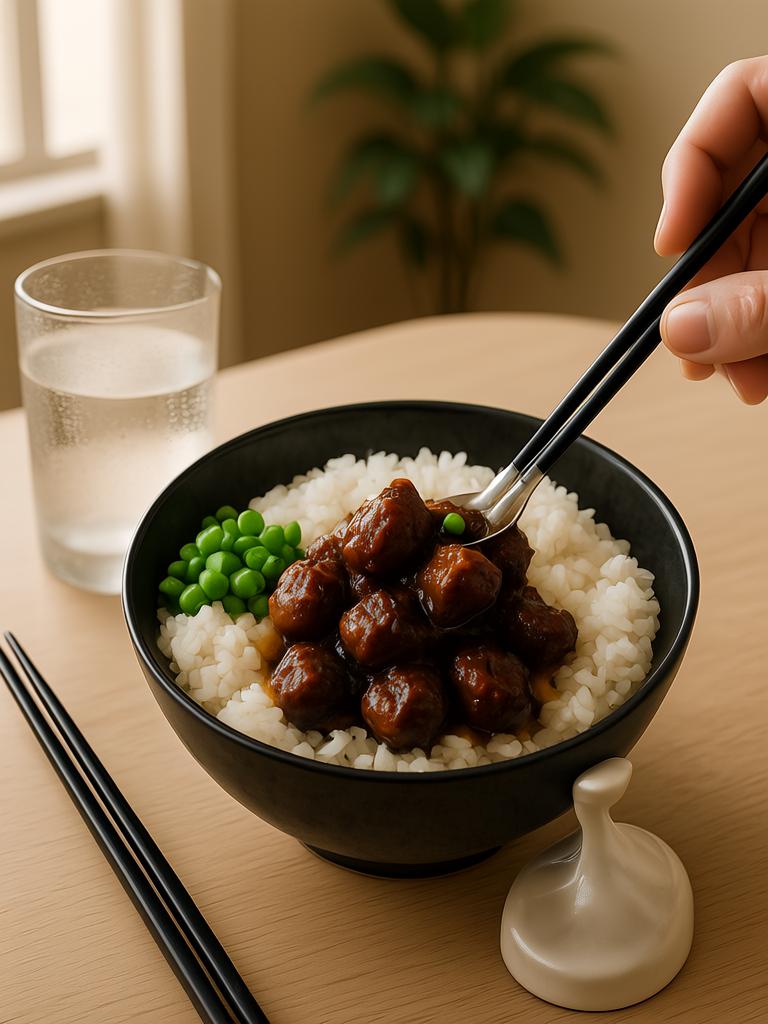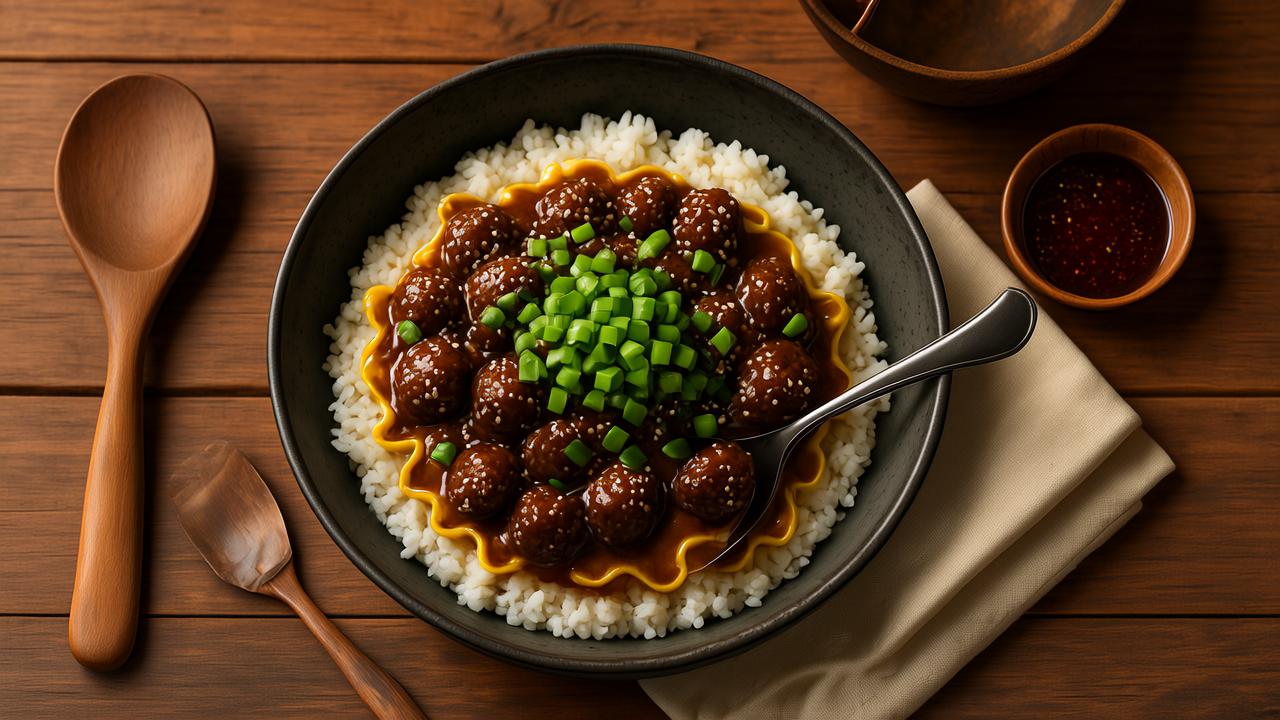It starts with a scent.
Hot oil, a hit of garlic, and that warm, caramel whisper of soy and sugar catching fire just long enough to wake the senses.
This is not the Mongolian beef you’re used to.
This is savory Mongolian ground beef with garlic and spring onions—a leaner, sharper, weeknight warrior that punches high above its weight.
Let’s break it down. Not just the recipe, but why it works, how it evolves, and what makes it so addictive.
Why Ground Beef, Not Sliced Steak?
It’s about balance.
Flank steak, the usual suspect in Mongolian beef, brings texture—but not everyone’s got time or budget for it.
Ground beef? That’s where smart cooking steps in. It’s cheaper, faster, and honestly, more forgiving.
When you brown it right—like really let it crisp—you get little nuggets of umami magic that sliced beef just can’t deliver.
Plus, the surface area of ground meat soaks up sauce like a dry sponge hitting a puddle. Every bite tastes like something you wanna keep eating.
The Base Flavors: A Bit of Science, A Lot of Soul
Garlic. Spring onions. Soy sauce. Brown sugar.
That’s your power squad right there.
But not all garlic is equal.
Freshly minced cloves (never from the jar) release allicin, that pungent, sweet-smelling compound that changes everything once it hits hot oil. It blooms fast, so timing’s critical—overcook it and it goes bitter.
Spring onions? You’re using both parts. The white is sharper, more aggressive. The green tops? Sweet, grassy, aromatic. You add those last.
Soy sauce—go for low-sodium, but don’t skimp.
You want it to season the beef, not drown it. The saltiness should hug the meat, not bully it.
Now, about that sugar: brown is best. The molasses content adds depth.
White sugar just won’t bring the same bass notes. And if you ever caramelized it slightly before adding liquids? Oof. Game changer.

Cooking Techniques: The Art of Heat and Patience
This dish isn’t about multitasking.
It’s about timing.
You want that beef brown—not gray. Gray means steamed. Steamed is sad.
Don’t crowd the pan. Give it space to fry. Use a cast iron skillet if you’ve got it. Stainless steel works, too. Nonstick? Meh. You won’t get the same crispy edges.
Brown it in batches if you must. Then—and only then—bring in the aromatics.
Garlic goes in once the beef is browned. Not before.
You’re not making garlic oil, you’re building a base. Let that garlic melt into the fat and cling to the meat.
Then comes the sauce. You want that sweet-salty-savory drizzle to sizzle on contact. It should reduce slightly, not pool at the bottom like soup.
Spring onions get folded in last. They’re your freshness. Your crunch.
Too early and they wilt into oblivion.
Mongolian Beef Origins: What the Dish Actually Is (and Isn’t)
Despite its name, Mongolian beef has no roots in Mongolia.
It’s an American-Chinese restaurant invention, often credited to the kitchens of Taiwanese teppanyaki joints in the 1950s-60s.
You’re not eating a dish from Ulaanbaatar.
You’re eating a flavor profile inspired by Chinese-style sauces—mainly soy, ginger, and sugar—wrapped in a format Americans crave: meat, sauce, and rice.
This version? A modern remix. Ground beef brings it home.
Flavor Additions & Variations That Just Work
Want to jazz it up without wrecking it? Try these:
1. Ginger:
A teaspoon of minced fresh ginger adds warmth and complexity. It pairs beautifully with garlic.
Powdered? Meh, it’s dusty. Go fresh or skip.
2. Chili Flakes or Gochujang:
For heat lovers. Adds bite and balances the sweetness.
Even a dab of sambal oelek will do.
3. Rice Vinegar or Shaoxing Wine:
A dash of acidity brightens everything. Just don’t overdo it—you want lift, not sourness.
4. Sesame Oil:
Just a few drops after cooking. Adds nuttiness, not to be confused with cooking oil.
5. Veggies:
Not traditional, but sliced bell peppers, shredded carrots, or snap peas can go in right before the sauce.
Don’t overcrowd or you’ll lose the crisp.
Serving Suggestions: It’s Not Just About Rice
Sure, steamed white rice is the go-to.
But don’t box yourself in.
1. Jasmine Rice: Fragrant and soft. Soaks up sauce like a champ.
2. Brown Rice: Adds chew and nuttiness. A good match for sweeter sauces.
3. Cauliflower Rice: If you’re watching carbs, this does the trick without sacrificing texture.
4. Noodles: Lo mein, rice noodles, or even ramen work. Toss ’em in at the end and let them mop up the flavor.
5. Lettuce Wraps: For something light and crunchy. Bibb or butter lettuce holds the meat beautifully.
Nutrition Breakdown (approx. per serving w/ rice)
- Calories: ~460
- Protein: 26g
- Fat: 24g
- Carbs: 34g
- Sodium: 980mg
- Sugar: 14g
Keep in mind, this swings wildly depending on brand choices, portion sizes, and any extras.
Want leaner? Use 90/10 ground beef.
Want to bulk it up with fiber? Add edamame or diced zucchini.

Misconceptions and Mistakes Pros Avoid
Mistake 1: Overcrowding the pan.
Steam happens. Texture disappears.
Mistake 2: Skimping on aromatics.
This dish lives and dies by garlic and green onions. Don’t shy away.
Mistake 3: Not reducing the sauce.
If it’s watery, it ain’t Mongolian beef. Simmer until glossy and slightly sticky.
Mistake 4: Using high-sodium soy sauce without adjusting.
You’ll ruin the balance. Always taste and tweak.
Mistake 5: Rushing it.
Ironically, this “quick dish” rewards patience. Let each step do its thing.
Emerging Trends: Why This Dish Keeps Getting Hotter
With the rise of weeknight-friendly recipes and meal-prep content, Mongolian-style ground beef has found a new audience.
TikTok and YouTube are loaded with variations.
From spicy Korean fusion versions to keto-friendly bowls, the versatility of this base recipe has made it a favorite.
It’s also adaptable. Whether you’re feeding picky kids or experimenting with international spices, the foundation holds strong.
Even meal kit services like HelloFresh and Blue Apron have leaned in, offering versions with different proteins, grains, and veggie swaps.
Real World Chef Insight: What Pros Say
Chef Lien Nguyen, a Seattle-based fusion chef, says:
“You’re not just cooking beef. You’re caramelizing protein, managing moisture, and layering heat. Ground beef can be a canvas—if you treat it like one.”
Chef Marcus Yan, formerly of a Michelin-starred pan-Asian bistro:
“It’s not about fancy ingredients—it’s about precision. Time your sauce reduction. Toast your garlic, don’t burn it. That’s how you elevate a cheap cut.”
They’re right. This dish doesn’t need prestige ingredients.
It needs attention. It needs rhythm.
Final Thoughts: The Soul of Mongolian Ground Beef
This isn’t just another stir-fry.
It’s comfort food redefined—bold, fast, and satisfying in ways most 20-minute meals never manage.
Use high heat. Don’t rush the browning. Respect your aromatics.
And most importantly—taste. Adjust. Taste again.
Because Mongolian ground beef with garlic and spring onions isn’t about perfection.
It’s about chasing delicious.
And trust me… it’s not far off.
FAQs
What is Mongolian ground beef made of?
It’s made with ground beef, garlic, spring onions, soy sauce, brown sugar, and optional spices or sauces for added flavor.
Can I use chicken or turkey instead of beef?
Yes, ground chicken or turkey works great as a leaner alternative.
Is Mongolian ground beef spicy?
Not by default, but you can add chili flakes, gochujang, or sambal to make it spicy.
What type of soy sauce should I use?
Use low-sodium soy sauce to keep the saltiness in check while still packing flavor.
Can I meal prep Mongolian ground beef?
Absolutely—it stores and reheats well for up to 4 days in the fridge.
What’s the best rice to serve it with?
Jasmine rice is ideal, but brown rice, noodles, or even lettuce wraps work too.
Can I add vegetables to this dish?
Yes, bell peppers, shredded carrots, or snap peas make great add-ins without overpowering it.
Why is my beef turning gray instead of brown?
It’s likely overcrowded in the pan—cook in batches for proper browning.
What’s the key to making the sauce stick?
Let it reduce until glossy and slightly thick—it should cling to the beef, not pool.
Is this dish gluten-free?
Only if you use gluten-free soy sauce or tamari—regular soy sauce contains wheat.
Can I freeze Mongolian ground beef?
Yes, it freezes well for up to 2 months in an airtight container.

Mariana is a passionate home cook who creates delicious, easy-to-follow recipes for busy people. From energizing breakfasts to satisfying dinners and indulgent desserts, her dishes are designed to fuel both your body and hustle.
When she’s not in the kitchen, she’s exploring new flavors and dreaming up her next recipe to share with the Foodie Hustle community.

